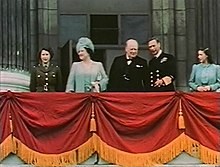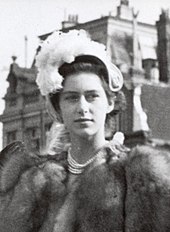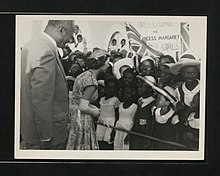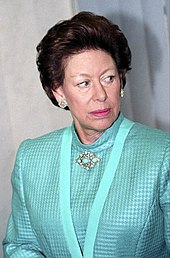Princess Margaret, Countess of Snowdon
Margaret's education was mainly supervised by her mother, who in the words of Randolph Churchill "never aimed at bringing her daughters up to be more than nicely behaved young ladies".Less than a year later, in December 1936, Edward abdicated to marry Wallis Simpson, a twice-divorced American, whom neither the Church of England nor the Dominion governments would accept as queen.[22][23] At the outbreak of World War II, Princesses Margaret and Elizabeth were at Birkhall, on the Balmoral Castle estate, where they stayed until Christmas 1939, enduring nights so cold that drinking water in carafes by their bedside froze.[25] Lord Hailsham wrote to Winston Churchill to advise the evacuation of the princesses to the greater safety of Canada,[26] to which their mother famously replied, "The children won't go without me.During a private visit to Paris in 1951, Margaret and Prince Nicholas of Yugoslavia were followed into a nightclub by a paparazzo who took photographs of them until British detectives physically removed him from the club.[61] The press avidly discussed "the world's most eligible bachelor-girl"[62] and her alleged romances with more than 30 bachelors,[63][64] including David Mountbatten, Michael I of Romania,[65] Dominic Elliot,[66] Colin Tennant (later Baron Glenconner),[67] Prince Henry of Hesse-Kassel,[68] and future Canadian prime minister John Turner.[62][72] During her 21st birthday party at Balmoral in August 1951,[73] the press was disappointed to only photograph Margaret with Townsend,[63] always in the background of pictures of royal appearances,[74][64] and to her parents a safe companion as Elizabeth's duties increased.[64] The following month her father underwent surgery for lung cancer, and Margaret was appointed one of the Counsellors of State who undertook the King's official duties while he was incapacitated.[78][77][64] He may have been aware of Margaret's infatuation with the non-titled and non-wealthy Townsend, reportedly seeing the courtier reluctantly obey the princess's order to carry her up palace stairs after a party.With the headline "They Must Deny it NOW",[84] the front-page article warned that "scandalous rumours about Princess Margaret are racing around the world", which the newspaper stated were "of course, utterly untrue".[74] Churchill discussed the marriage at the 1953 Commonwealth Prime Ministers' Conference held with the coronation; the Statute of Westminster 1931 requires Dominion parliaments to also approve any Bill of Renunciation changing the line of succession.[64][41] At the age of 25 Margaret would not need the Queen's permission under the 1772 Act;[109] she could, after notifying the Privy Council of the United Kingdom, marry in one year if Parliament did not prevent her.The attaché secretly travelled to Britain; while the palace was aware of one visit, he reportedly made other trips for nights and weekends with the princess at Clarence House—her apartment had its own front door—and friends' homes.Stating that people were more interested in the couple than the recent 1955 United Kingdom general election, on 29 May the Daily Express published an editorial demanding that Buckingham Palace confirm or deny the rumours.[109] Margaret's authorized biographer Christopher Warwick said that the letter was evidence that her love for Townsend was not as strong as the public believed, and that she wanted only the prime minister and Elizabeth to know of her uncertainty.[49] An influential 26 October editorial in The Times stating that "The QUEEN's sister married to a divorced man (even though the innocent party) would be irrevocably disqualified from playing her part in the essential royal function" represented The Establishment's view of what it considered a possibly dangerous crisis.While the government could not prevent the marriage when Margaret became a private individual after a Bill of Renunciation, she would no longer be a Counsellor of State and would lose her civil list allowance; otherwise, taxpayers would subsidise a divorced man and his sons.[63] The Associated Press said that Margaret's statement was almost "a rededication of her life to the duties of royalty, making unlikely any marriage for her in the near future";[119] the princess may have expected to never marry after the long relationship ended, because most of her eligible male friends were no longer bachelors.[126] Barrymaine agreed that Margaret intended the statement to mean that she would never marry, but wrote that Townsend likely did not accept any such vow to him by the princess, and his subsequent departure from Britain for two years was to not interfere with her life.[84] After resigning from the RAF and travelling around the world for 18 months Townsend returned in March 1958; he and Margaret met several times, but could not avoid the press ("TOGETHER AGAIN") or royal disapproval.[135][136] She reportedly accepted his proposal a day after learning from Townsend that he intended to marry a young Belgian woman,[63] Marie-Luce Jamagne, who was half his age and greatly resembled Margaret.[156] Beyond extramarital relationships, the marriage was accompanied by drugs, alcohol, and bizarre behaviour by both parties, such as Snowdon's leaving lists of "things I hate about you" for Margaret to find between the pages of books she read.[185] That October, while on a fundraising tour of the United States on behalf of the Royal Opera House, Margaret was seated at a dinner reception in Chicago with columnist Abra Anderson and Mayor Jane Byrne.[16] In her capacity as president of the Royal Ballet, she played a key role in launching a fund for Dame Margot Fonteyn, who was experiencing financial troubles.[208] Margaret died in her sleep at King Edward VII's Hospital, London, at 06:30 GMT on 9 February 2002, aged 71, three days after the 50th anniversary of her father's death.[222] Another memorial service to mark the 10th anniversary of their deaths was held on 30 March 2012 at St George's Chapel, Windsor Castle, which was attended by Queen Elizabeth II and other members of the royal family.[228] Marion Crawford wrote in her memoir: "Impulsive and bright remarks she made became headlines and, taken out of their context, began to produce in the public eye an oddly distorted personality that bore little resemblance to the Margaret we knew.[236] Margaret was described by her cousin Lady Elizabeth Shakerley as "somebody who had a wonderful capacity for giving a lot of people pleasure and she was making a very, very, very good and loyal friend".[243] Marie Claire stated that the princess "refused to compromise" on her style later in life, continuing with trends of big sleeves and strapless evening gowns.[249] In June 2006, much of Margaret's estate was auctioned by Christie's to meet the tax and, in her son's words, "normal family requirements such as educating her grandchildren",[250] though some of the items were sold in aid of charities such as the Stroke Association.















Princess Margaret (disambiguation)Glamis CastleKing Edward VII's HospitalSt George's ChapelKing George VI Memorial ChapelAntony Armstrong-Jones, 1st Earl of SnowdonDavid Armstrong-Jones, 2nd Earl of SnowdonLady Sarah ChattoWindsorGeorge VIElizabeth Bowes-LyonKing George VIQueen Elizabeth The Queen MotherQueen Elizabeth IIBritish thronethe abdicationEdward VIIIheir presumptiveSecond World WarWindsor CastlesocialitesPeter Townsendher father diedArchbishop of CanterburymarriedAntony Armstrong-JonesEarl of SnowdonBritish royal familyHenry SimsonHome SecretaryJ. R. Clynesregistration of her birthavoid her being numbered thirteenparish registerBuckingham PalaceCosmo Langsuccession to the British thronePrince Albert, Duke of YorkElizabeth, Duchess of YorkKing George VQueen MaryClaude Bowes-Lyon, 14th Earl of Strathmore and KinghorneCecilia Bowes-Lyon, Countess of Strathmore and KinghornePiccadillytown houseRoyal Lodgeher uncle Prince George's weddingElizabethMarion CrawfordRandolph ChurchillgovernessJ. M. BarriePeter PanMargaret's grandfather diedEdward VIIIEdward abdicatedWallis SimpsonDominionThe MallBrownieGirl GuideGirlguiding UKWorld War IIBalmoral CastleSandringham HouseLord HailshamWinston Churchillthe princesses staged pantomimesChildren's Hourroyal familyAuxiliary Territorial Service8 May 1945confirmedChurch of Englandequerrywedding of Princess Elizabeth and Philip MountbattenPhilipPrince CharlesPrincess Anneunauthorized biographyThe Little PrincessesSharman DouglasLewis Williams DouglasThe 400 ClubCafé de ParisMirabelleMarquess of BlandfordPeter WardBilly WallaceDanny KayeLondon Palladiumthe US ambassador's residencecan-canPrince Nicholas of YugoslaviaMark Bonham CarterEddie FisherThe FrogScala TheatreJudy MontaguDavid MountbattenMichael I of RomaniaDominic ElliotColin TennantPrince Henry of Hesse-KasselJohn TurnerLord DalkeithCounsellors of StateCraig BrownNational TrustQueen Juliana of the NetherlandsRosemaryher father's deathClarence HouseComptrollerQueen Mother's householdRoyal Windsor Horse ShowSir Alan LascellesRoyal Marriages Act 1772Queen Mary had recently diedcoronation of Elizabeth IIThe PeopleRegency Act 1953Daily MirrorRab ButlerClementine ChurchillGeoffrey Fisher